Machine-Learning Approach Using SAR Data for the Classification of Oil Palm Trees That Are Non-Infected and Infected with the Basal Stem Rot Disease
Abstract
1. Introduction
2. Materials and Methods
2.1. Study Area
2.2. Field Survey Data
2.3. Dataset Description
2.4. Data Analysis and Evaluation
2.4.1. SAR Image Pre-Processing
2.4.2. Training Data
2.4.3. Imbalance Data Approach
Data Sampling
2.4.4. Classification
Machine Learning Approach
Accuracy Assessment
3. Results
3.1. Sensitivity of Variables of Backscatter Used
3.2. Effects of Classifiers on the Model Performance
4. Discussion
4.1. Sensitivity of Variables of Backscatter Used
4.2. Effects of Classifiers on the Model Performance
5. Conclusions
Author Contributions
Funding
Data Availability Statement
Acknowledgments
Conflicts of Interest
References
- Varga, S. Essential Palm Oil Statistics 2017. Palm Oil Anal. 2017, 1, 4–26. [Google Scholar]
- Hushiarian, R.; Yusof, N.A.; Dutse, S.W. Detection and control of Ganoderma boninense: Strategies and perspectives. Springerplus 2013, 2, 1–12. [Google Scholar] [CrossRef]
- Roslan, A.; Idris, A.S. Economic Impact of Ganoderma Incidence on Malaysian Oil Palm Plantation–a Case Study in Johor. Oil Palm Ind. Econ. J. 2012, 12, 24–30. [Google Scholar]
- Lai, O.-M.; Tan, C.-P.; Akoh, C.C. Palm Oil: Production, Processing, Characterisation, and Uses; AOCS Press: Urbana, IL, USA, 2012; ISBN 9780981893693. [Google Scholar]
- Mohammed, C.L.; Rimbawanto, A.; Page, D.E. Management of basidiomycete root- and stem-rot diseases in oil palm, rubber and tropical hardwood plantation crops. For. Pathol. 2014, 44, 428–446. [Google Scholar] [CrossRef]
- Priwiratama, H.; Susanto, A. Utilization of Fungi for the Biological Control. of Insect Pests and Ganoderma Disease in the Indonesian Oil Palm Industry. J. Agric. Sci. Technol. 2014, 4, 103–111. [Google Scholar]
- Santoso, H.; Tani, H.; Wang, X. Random Forest classification model of basal stem rot disease caused by Ganoderma boninense in oil palm plantations. Int. J. Remote Sens. 2017. [Google Scholar] [CrossRef]
- Singh, G. Ganoderma—The scourge of oil palm in the coastal area. In Proceedings of the Ganoderma workshop, Bangi, Selangor, Malaysia, 11 September 1990; Palm Oil Research Institute of Malaysia: Kuala Lumpur, Malaysia, 1991; pp. 7–35. [Google Scholar]
- Turner, P.D. Oil Palm Diseases and Disorders; Oxford Univ. Press: Kuala Lumpur, Malaysia, 1981; ISBN 0195804686. [Google Scholar]
- Rahmahwati, R.; Zulkilfli, A.M.; Ramle, M. Factors Affecting Yield Achieved by Participants of the Quality Oil Palm Seedlings Assistance Scheme in Sabah and Sarawak. Oil Palm Ind. Econ. J. 2019, 19, 44–56. [Google Scholar]
- Khaled, A.Y.; Abd Aziz, S.; Bejo, S.K.; Nawi, N.M.; Seman, I.A.; Onwude, D.I. Early detection of diseases in plant tissue using spectroscopy–applications and limitations. Appl. Spectrosc. Rev. 2018, 53, 36–64. [Google Scholar] [CrossRef]
- Khosrokhani, M.; Khairunniza-Bejo, S.; Pradhan, B. Geospatial technologies for detection and monitoring of Ganoderma basal stem rot infection in oil palm plantations: A review on sensors and techniques. Geocarto Int. 2018, 33, 260–276. [Google Scholar] [CrossRef]
- Liaghat, S.; Ehsani, R.; Mansor, S.; Shafri, H.Z.M.; Meon, S.; Sankaran, S.; Azam, S.H.M.N. Early detection of basal stem rot disease (Ganoderma) in oil palms based on hyperspectral reflectance data using pattern recognition algorithms. Int. J. Remote Sens. 2014, 35, 3427–3439. [Google Scholar] [CrossRef]
- Shafri, H.Z.M.; Anuar, M.I.; Seman, I.A.; Noor, N.M. Spectral discrimination of healthy and ganoderma-infected oil palms from hyperspectral data. Int. J. Remote Sens. 2011, 32, 7111–7129. [Google Scholar] [CrossRef]
- Lelong, C.C.D.; Roger, J.M.; Brégand, S.; Dubertret, F.; Lanore, M.; Sitorus, N.A.; Raharjo, D.A.; Caliman, J.P. Evaluation of oil-palm fungal disease infestation with canopy hyperspectral reflectance data. Sensors 2010, 10, 734–747. [Google Scholar] [CrossRef] [PubMed]
- Shafri, H.Z.M.; Hamdan, N. Hyperspectral imagery for mapping disease infection in oil palm plantation using vegetation indices and red edge techniques. Am. J. Appl. Sci. 2009, 6, 1031–1035. [Google Scholar] [CrossRef]
- Santoso, H.; Gunawan, T.; Jatmiko, R.H.; Darmosarkoro, W.; Minasny, B. Mapping and identifying basal stem rot disease in oil palms in North Sumatra with QuickBird imagery. Precis. Agric. 2011, 12, 233–248. [Google Scholar] [CrossRef]
- Xie, Y.; Sha, Z.; Yu, M. Remote sensing imagery in vegetation mapping: A review. J. Plant Ecol. 2008, 1, 9–23. [Google Scholar] [CrossRef]
- Kakaes, K.; Greenwood, F.; Lippincot, M.; Dosemagen, S.; Meier, P.; Wich, S. Drones and Aerial Observation: New Technologies for Property Rights, Human Rights, and Global Development A Primer; New America: Washington, DC, USA, 2015. [Google Scholar]
- Al-Wassai, F.A.; Kalyankar, N.V. Image Fusion Technologies in Commercial Remote Sensing Packages. arXiv 2013, arXiv:1307.2440. [Google Scholar]
- Wang, D.; Su, Y.; Zhou, Q.; Chen, Z. Advances in research on crop identification using SAR. In Proceedings of the 2015 Fourth International Conference on Agro-Geoinformatics (Agro-Geoinformatics), Istanbul, Turkey, 20–24 July 2015; pp. 312–317. [Google Scholar] [CrossRef]
- Chakraborty, M.; Manjunath, K.R.; Panigrahy, S.; Kundu, N.; Parihar, J.S. Rice crop parameter retrieval using multi-temporal, multi-incidence angle Radarsat SAR data. ISPRS J. Photogramm. Remote Sens. 2005, 59, 310–322. [Google Scholar] [CrossRef]
- Shao, Y.; Fan, X.; Liu, H.; Xiao, J.; Ross, S.; Brisco, B.; Brown, R.; Staples, G. Rice monitoring and production estimation using multitemporal RADARSAT. Remote Sens. Environ. 2001, 76, 310–325. [Google Scholar] [CrossRef]
- Moran, M.S.; Inoue, Y.; Barnes, E.M. Opportunities and limitations for image-based remote sensing in precision crop management. Remote Sens. Environ. 1997, 61, 319–346. [Google Scholar] [CrossRef]
- Huang, W.; Sun, G.; Ni, W.; Zhang, Z.; Dubayah, R. Sensitivity of Multi-Source SAR Backscatter to Changes in Forest aboveground Biomass. Remote Sens. 2015, 7, 9587–9609. [Google Scholar] [CrossRef]
- Patel, P.; Srivastava, H.S.; Panigrahy, S.; Parihar, J.S. Comparative evaluation of the sensitivity of multi-spolarised multi-frequency SAR backscatter to plant density. Int. J. Remote Sens. 2006, 27, 293–305. [Google Scholar] [CrossRef]
- Srivastava, H.S.; Patel, P.; Navalgund, R.R. Application Potentials of Synthetic Aperture Radar Interferometry for Land-Cover Mapping and Crop-Height Estimation. Curr. Sci. 2006, 91, 783–788. [Google Scholar]
- Krapivin, V.F.; Varotsos, C.A.; Soldatov, V.Y. New Ecoinformatics Tools in Environmental Science: Applications and Decision-Making; Springer: Vienna, Austria, 2015; ISBN 9783319139784. [Google Scholar]
- Silva, W.F.; Rudorff, B.F.T.; Formaggio, A.R.; Paradella, W.R.; Mura, J.C. Simulated multipolarized MAPSAR images to distinguish agricultural crops. Sci. Agric. 2012, 69, 201–209. [Google Scholar] [CrossRef][Green Version]
- Holmes, M.G. Monitoring vegetation in the future: Radar. Bot. J. Linn. Soc. 1992, 108, 93–109. [Google Scholar] [CrossRef]
- Chang, C.-W.; Lee, H.-W.; Liu, C.-H. A Review of Artificial Intelligence Algorithms Used for Smart Machine Tools. Inventions 2018, 3, 41. [Google Scholar] [CrossRef]
- Brodley, C.E.; Friedl, M.A. Decision tree classification of land cover from remotely sensed data. Remote Sens. Environ. 1997, 61, 399–409. [Google Scholar] [CrossRef]
- Qian, Y.; Zhou, W.; Yan, J.; Li, W.; Han, L.; Qian, Y.; Zhou, W.; Yan, J.; Li, W.; Han, L. Comparing Machine Learning Classifiers for Object-Based Land Cover Classification Using Very High Resolution Imagery. Remote Sens. 2014, 7, 153–168. [Google Scholar] [CrossRef]
- Chen, Y.; Dou, P.; Yang, X. Improving Land Use/Cover Classification with a Multiple Classifier System Using AdaBoost Integration Technique. Remote Sens. 2017, 9, 1055. [Google Scholar] [CrossRef]
- Guidici, D.; Clark, M. One-Dimensional Convolutional Neural Network Land-Cover Classification of Multi-Seasonal Hyperspectral Imagery in the San Francisco Bay Area, California. Remote Sens. 2017, 9, 629. [Google Scholar] [CrossRef]
- Stojanova, D.; Panov, P.; Gjorgjioski, V.; Kobler, A.; Džeroski, S. Estimating vegetation height and canopy cover from remotely sensed data with machine learning. Ecol. Inform. 2010, 5, 256–266. [Google Scholar] [CrossRef]
- Cho, M.A.; Mathieu, R.; Asner, G.P.; Naidoo, L.; van Aardt, J.; Ramoelo, A.; Debba, P.; Wessels, K.; Main, R.; Smit, I.P.J.; et al. Mapping tree species composition in South African savannas using an integrated airborne spectral and LiDAR system. Remote Sens. Environ. 2012, 125, 214–226. [Google Scholar] [CrossRef]
- Dalponte, M.; Frizzera, L.; Ørka, H.O.; Gobakken, T.; Næsset, E.; Gianelle, D. Predicting stem diameters and aboveground biomass of individual trees using remote sensing data. Ecol. Indic. 2018, 85, 367–376. [Google Scholar] [CrossRef]
- Lee, J.; Im, J.; Kim, K.; Quackenbush, L. Machine Learning Approaches for Estimating Forest Stand Height Using Plot-Based Observations and Airborne LiDAR Data. Forests 2018, 9, 268. [Google Scholar] [CrossRef]
- Shekoofa, A.; Emam, Y.; Shekoufa, N.; Ebrahimi, M.; Ebrahimie, E. Determining the most important physiological and agronomic traits contributing to smaise grain yield through machine learning algorithms: A new avenue in intelligent agriculture. PLoS ONE 2014, 9, e97288. [Google Scholar] [CrossRef]
- Lillo-Saavedra, M.F.; Gonzalo-Martín, C.; García-Pedrero, A.; Rodriguéz-Esparragón, D. A random forest and superpixels approach to sharpen thermal infrared satellite imagery. In Remote Sensing for Agriculture, Ecosystems, and Hydrology XIX; Neale, C.M., Maltese, A., Eds.; SPIE: Bellingham, DC, USA, 2007; Volume 10421, p. 104210H. [Google Scholar]
- Liakos, K.G.; Busato, P.; Moshou, D.; Pearson, S.; Bochtis, D. Machine learning in agriculture: A review. Sensors 2018, 18, 1–29. [Google Scholar] [CrossRef]
- Rumpf, T.; Mahlein, A.K.; Steiner, U.; Oerke, E.C.; Dehne, H.W.; Plümer, L. Early detection and classification of plant diseases with Support Vector Machines based on hyperspectral reflectance. Comput. Electron. Agric. 2010, 74, 91–99. [Google Scholar] [CrossRef]
- Ur Rahman, H.; Ch, N.J.; Manzoor, S.; Najeeb, F.; Siddique, M.Y.; Khan, R.A. A Comparative Analysis of Machine Learning Approaches for Plant Disease Identification. Adv. Life Sci. 2017, 4, 120–126. [Google Scholar]
- Thabtah, F.; Hammoud, S.; Kamalov, F.; Gonsalves, A. Data imbalance in classification: Experimental evaluation. Inf. Sci. 2020, 513, 429–441. [Google Scholar] [CrossRef]
- Chemchem, A.; Alin, F.; Krajecki, M. Combining SMOTE sampling and machine learning for forecasting wheat yields in France. In Proceedings of the IEEE 2nd International Conference on Artificial Intelligence and Knowledge Engineering, AIKE, Sardinia, Italy, 3–5 June 2019; Institute of Electrical and Electronics Engineers Inc.: Piscataway, NJ, USA, 2019; pp. 9–14. [Google Scholar]
- Ma, H.; Huang, W.; Jing, Y.; Yang, C.; Han, L.; Dong, Y.; Ye, H.; Shi, Y.; Zheng, Q.; Liu, L.; et al. Integrating growth and environmental parameters to discriminate powdery mildew and aphid ofwinter wheat using bi-temporal Landsat-8 imagery. Remote Sens. 2019, 11, 846. [Google Scholar] [CrossRef]
- Lee, J. Sen Digital Image Enhancement and Noise Filtering by Use of Local Statistics. IEEE Trans. Pattern Anal. Mach. Intell. 1980, PAMI-2, 165–168. [Google Scholar] [CrossRef] [PubMed]
- Frost, V.S.; Stiles, J.A.; Shanmugan, K.S.; Holtzman, J.C. A Model for Radar Images and Its Application to Adaptive Digital Filtering of Multiplicative Noise. IEEE Trans. Pattern Anal. Mach. Intell. 1982, PAMI-4, 157–166. [Google Scholar] [CrossRef] [PubMed]
- Kuan, D.T.; Sawchuk, A.A.; Strand, T.C.; Chavel, P. Adaptive Noise Smoothing Filter for Images with Signal-Dependent Noise. IEEE Trans. Pattern Anal. Mach. Intell. 1985, PAMI-7, 165–177. [Google Scholar] [CrossRef] [PubMed]
- Ozdarici, A.; Akyurek, Z. A Comparison of Sar Filtering Techniques on Agricultural Area Identification. In Proceedings of the ASPRS 2010 Annual Conference, San Diego, CA, USA, 26–30 April 2010; pp. 26–30. [Google Scholar]
- Mahdavi, S.; Salehi, B.; Moloney, C.; Huang, W.; Brisco, B. Speckle filtering of Synthetic Aperture Radar images using filters with object-size-adapted windows. Int. J. Digit. Earth 2018, 11, 703–729. [Google Scholar] [CrossRef]
- Rosenqvist, A.; Shimada, M.; Ito, N.; Watanabe, M. ALOS PALSAR: A pathfinder mission for global-scale monitoring of the environment. IEEE Trans. Geosci. Remote Sens. 2007, 45, 3307–3316. [Google Scholar] [CrossRef]
- Ryan Hoens, T.; Chawla, N.V. Imbalanced datasets: From sampling to classifiers. Imbalanced Learn. Found. Algorithms Appl. 2013, 43–59. [Google Scholar] [CrossRef]
- Chawla, N.V.; Bowyer, K.W.; Hall, L.O.; Kegelmeyer, W.P. SMOTE: Synthetic minority over-sampling technique. J. Artif. Intell. Res. 2002, 16, 321–357. [Google Scholar] [CrossRef]
- He, H.; Garcia, E.A. Learning from imbalanced data. IEEE Trans. Knowl. Data Eng. 2009, 21, 1263–1284. [Google Scholar] [CrossRef]
- Frank, E.; Hall, M.; Holmes, G.; Kirkby, R.; Pfahringer, B.; Witten, I.H.; Trigg, L. Weka-A Machine Learning Workbench for Data Mining. In Data Mining and Knowledge Discovery Handbook; Springer: Boston, MA, USA, 2009; pp. 1269–1277. [Google Scholar]
- Sarker, M.L.R.; Nichol, J.; Ahmad, B.; Busu, I.; Rahman, A.A. Potential of texture measurements of two-date dual polarization PALSAR data for the improvement of forest biomass estimation. ISPRS J. Photogramm. Remote Sens. 2012, 69, 146–166. [Google Scholar] [CrossRef]
- Omar, H.; Hamzah, K.A.; Ismail, M.H. The use of spolarised L-Band alos palsar for identifying forest cover in Peninsular Malaysia. In Proceedings of the 33rd Asian Conference on Remote Sensing, Pattaya, Thailand, 26–30 November 2012; Volume 1, pp. 263–272. [Google Scholar]
- Vabalas, A.; Gowen, E.; Poliakoff, E.; Casson, A.J. Machine learning algorithm validation with a limited sample size. PLoS ONE 2019, 14, e0224365. [Google Scholar] [CrossRef]
- Husin, N.A.; Khairunniza-Bejo, S.; Abdullah, A.F.; Kassim, M.S.M.; Ahmad, D.; Aziz, M.H.A. Classification of Basal Stem Rot Disease in Oil Palm Plantations Using Terrestrial Laser Scanning Data and Machine Learning. Agronomy 2020, 10, 1624. [Google Scholar] [CrossRef]
- Marius, P.; Balas, V.E.; Mastorakis, N.E.; Popescu, M.-C.; Balas, V.E. Multilayer Perceptron and Neural networks. WSEAS Trans. Circuits Syst. 2009, 8, 579–588. [Google Scholar]
- Stańczyk, U. Rough set and artificial neural network approach to computational stylistics. Smart Innov. Syst. Technol. 2013, 13, 441–470. [Google Scholar] [CrossRef]
- Immitzer, M.; Atzberger, C.; Koukal, T. Tree Species Classification with Random Forest Using very High Spatial Resolution 8-Band WorldView-2 Satellite Data. Remote Sens. 2012, 4, 2661–2693. [Google Scholar] [CrossRef]
- Berhane, T.; Lane, C.; Wu, Q.; Autrey, B.; Anenkhonov, O.; Chepinoga, V.; Liu, H. Decision-Tree, Rule-Based, and Random Forest Classification of High-Resolution Multispectral Imagery for Wetland Mapping and Inventory. Remote Sens. 2018, 10, 580. [Google Scholar] [CrossRef] [PubMed]
- Breiman, L. Random Forests. Mach. Learn. 2001, 45, 5–32. [Google Scholar] [CrossRef]
- Rodriguez-Galiano, V.F.; Ghimire, B.; Rogan, J.; Chica-Olmo, M.; Rigol-Sanchez, J.P. An assessment of the effectiveness of a random forest classifier for land-cover classification. ISPRS J. Photogramm. Remote Sens. 2012, 67, 93–104. [Google Scholar] [CrossRef]
- Jensen, J.R. Introductory digital image processing: A remote sensing perspective. Introd. Digit. image Process. Remote Sens. Perspect. 1996, 2, 65. [Google Scholar] [CrossRef]
- Hosmer, D.W.; Lemeshow, S. Assessing the Fit of the Model; Wiley: Hoboken, NJ, USA, 2000; pp. 143–202. [Google Scholar]
- Lopez-Sanchez, J.M.; Cloude, S.R.; Ballester-Berman, J.D. Rice phenology monitoring by means of SAR polarimetry at X-band. IEEE Trans. Geosci. Remote Sens. 2012, 50, 2695–2709. [Google Scholar] [CrossRef]
- You, H.; Ma, Z.; Tang, Y.; Wang, Y.; Yan, J.; Ni, M.; Cen, K.; Huang, Q. Comparison of ANN (MLP), ANFIS, SVM, and RF models for the online classification of heating value of burning municipal solid waste in circulating sfluidised bed incinerators. Waste Manag. 2017, 68, 186–197. [Google Scholar] [CrossRef] [PubMed]
- McPhail, C.; Maier, H.R.; Kwakkel, J.H.; Giuliani, M.; Castelletti, A.; Westra, S. Robustness Metrics: How Are They Calculated, When Should They Be Used and Why Do They Give Different Results? Earth’s Future 2018, 6, 169–191. [Google Scholar] [CrossRef]
- Ying, X. An Overview of Overfitting and its Solutions. J. Phys. Conf. Ser. 2019, 1168, 022022. [Google Scholar] [CrossRef]
- Dunne, R.A. A Statistical Approach to Neural Networks for Pattern Recognition; John Wiley & Sons, Inc.: Hoboken, NJ, USA, 2007; ISBN 9780470148150. [Google Scholar]
- Nawar, S.; Mouazen, A. Comparison between Random Forests, Artificial Neural Networks and Gradient Boosted Machines Methods of On-Line Vis-NIR Spectroscopy Measurements of Soil Total Nitrogen and Total Carbon. Sensors 2017, 17, 2428. [Google Scholar] [CrossRef]
- Ahmad, M.W.; Mourshed, M.; Rezgui, Y. Trees vs Neurons: Comparison between random forest and ANN for high-resolution prediction of building energy consumption. Energy Build. 2017, 147, 77–89. [Google Scholar] [CrossRef]
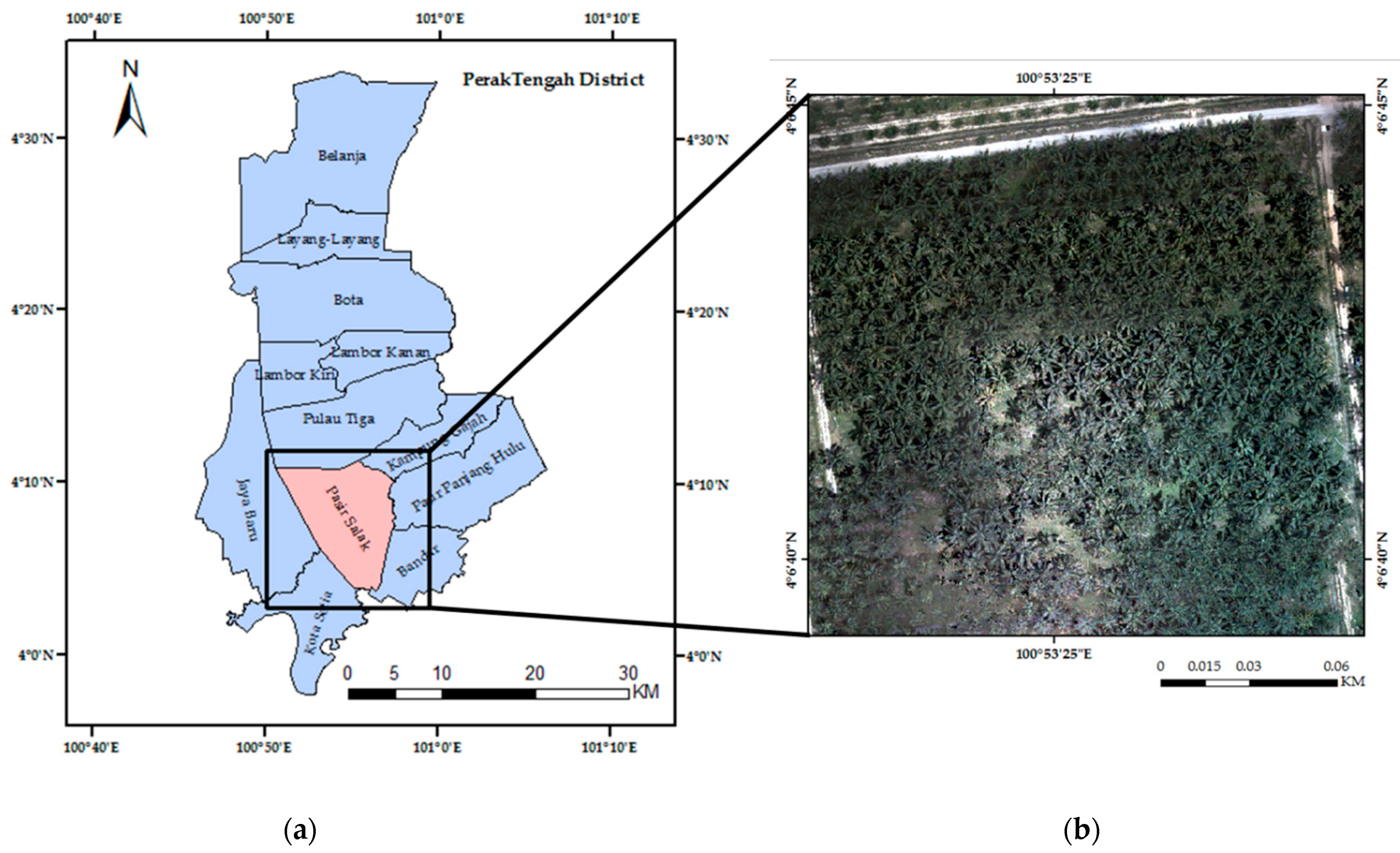
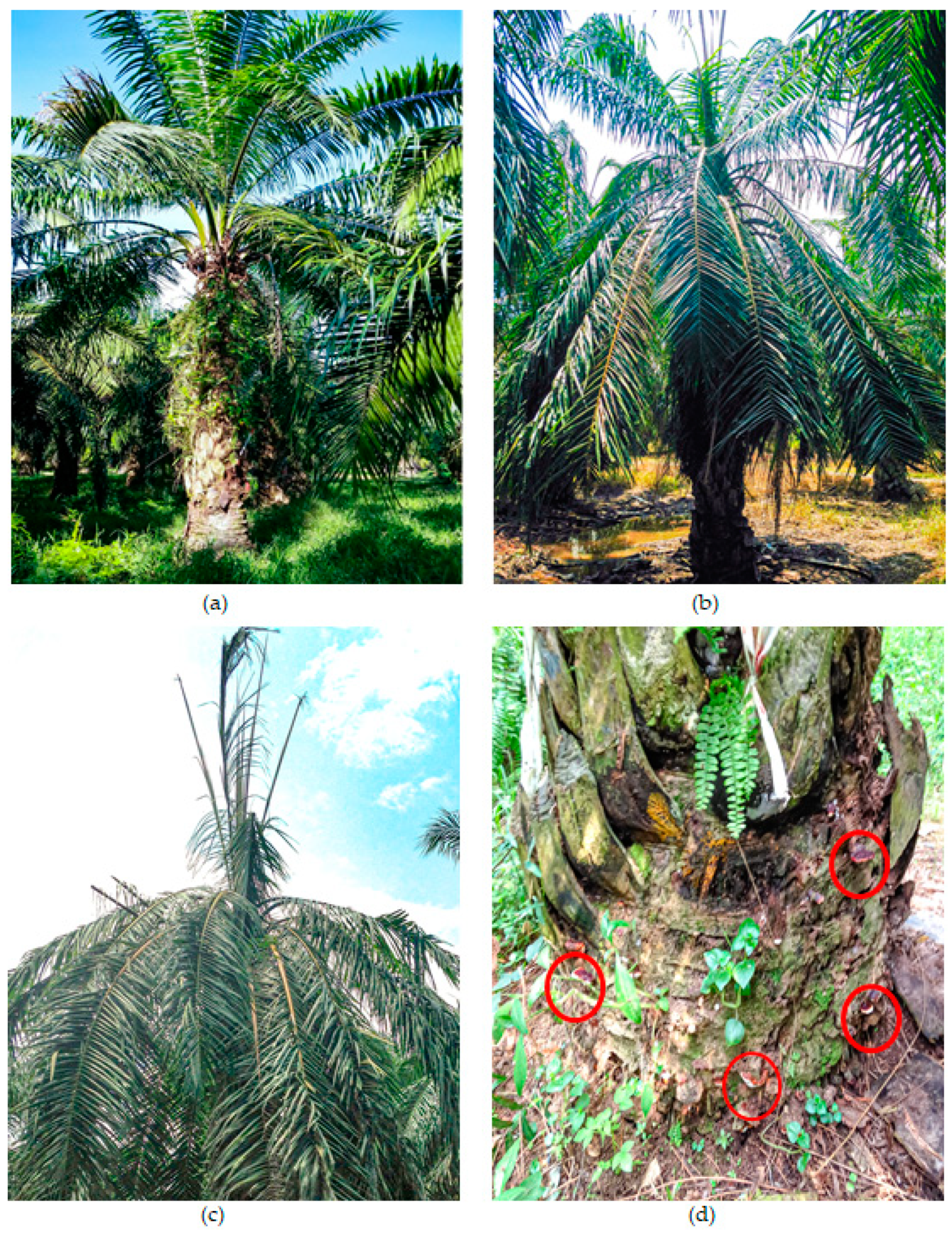
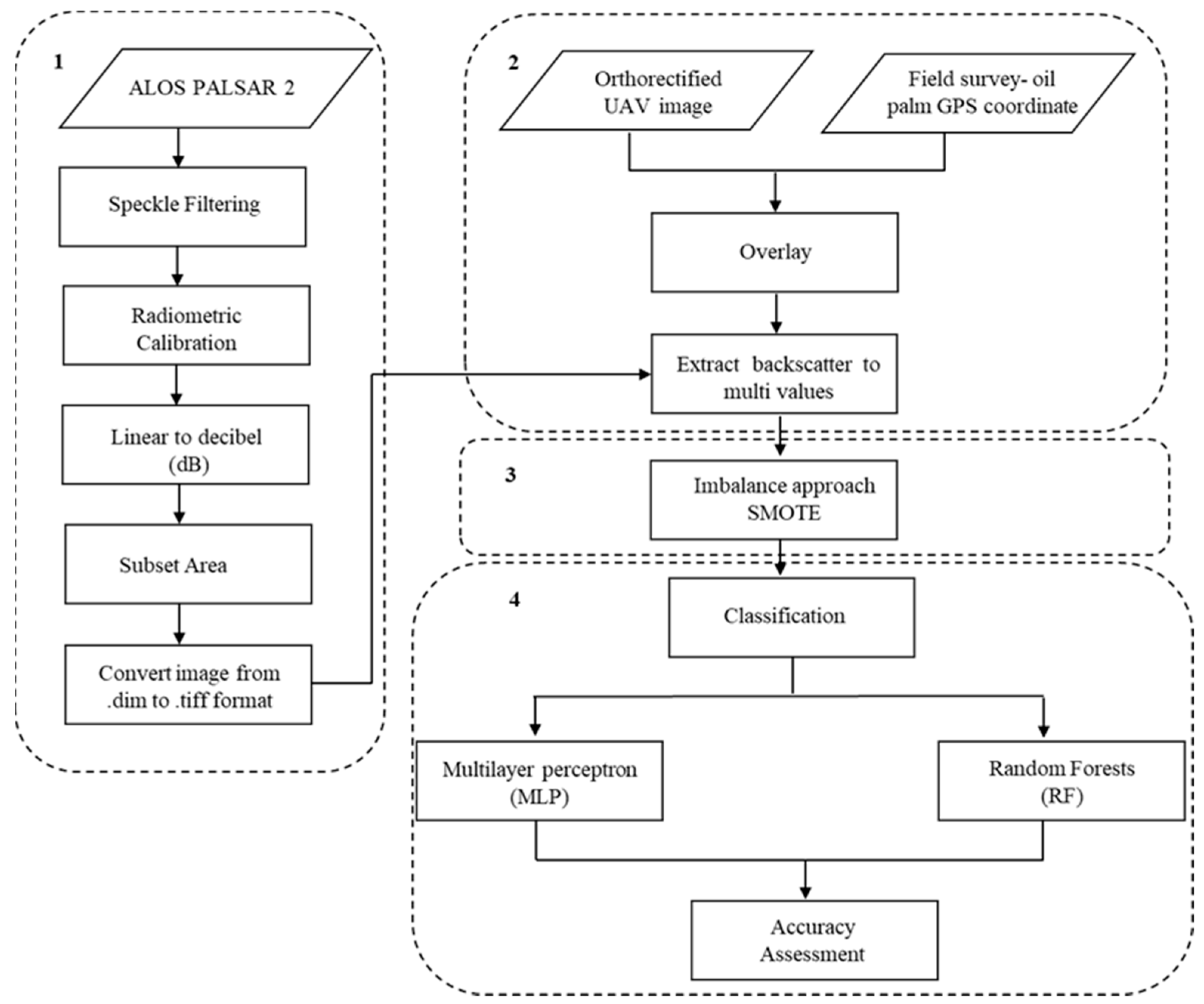
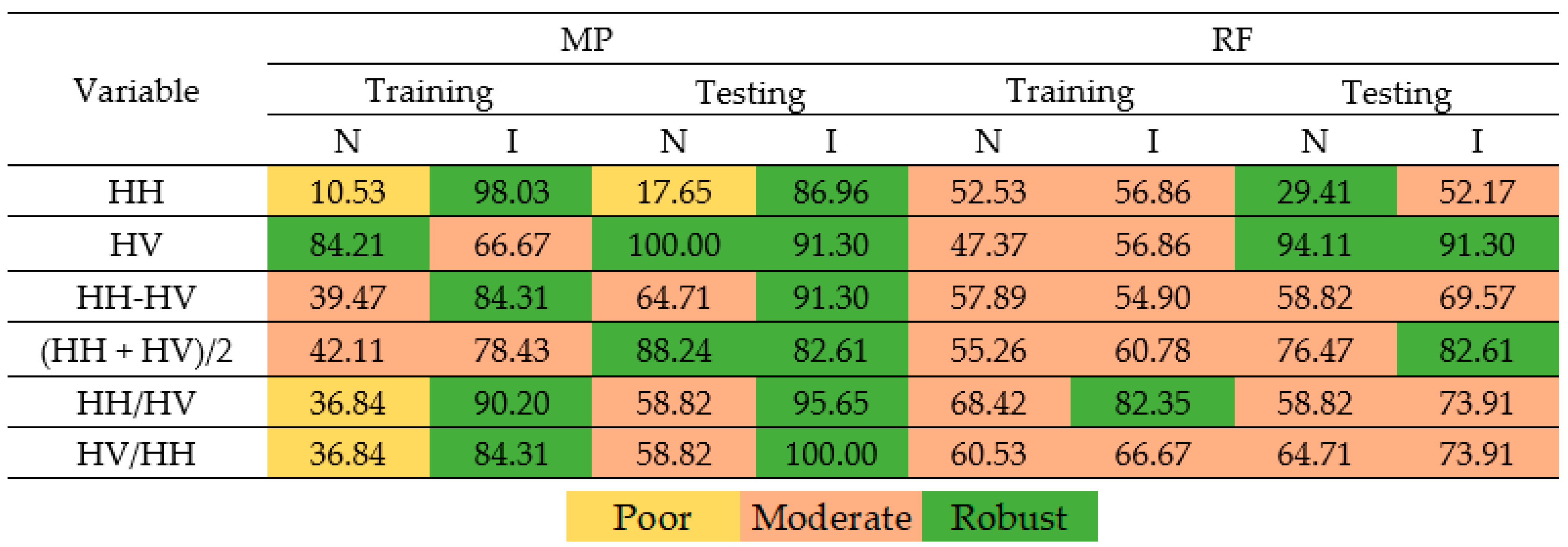
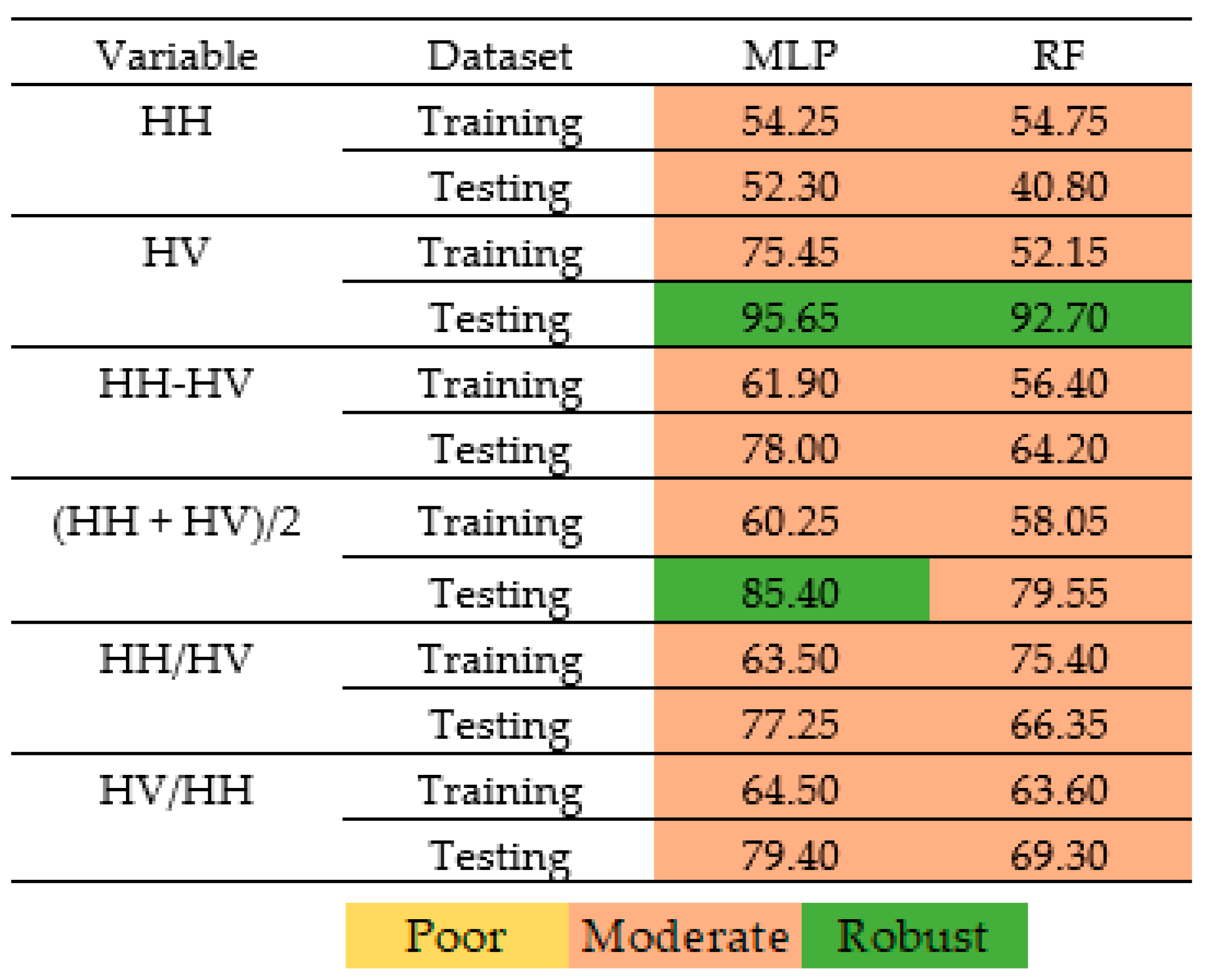

| Category | Description |
|---|---|
| Non-infected | Healthy palm, no foliage symptom (0%), no fruiting body |
| Infected | Foliage symptom more than 25%, produce fruiting bodies |
| ALOS PALSAR-2 Specification | ALOS PALSAR-2 Image View | |
|---|---|---|
| Observation Mode | Strip Map/High Resolution | |
| Calibration Factor | −83 | 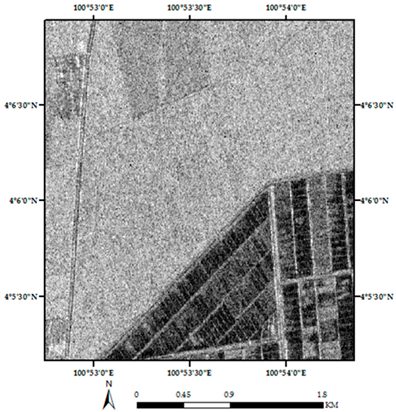 |
| Spatial Resolution | 10 m | |
| Pixel Spacing | 6.25 m (2 looks) | |
| Observation width | 70 km | |
| Product Processed Level | 1.5 | |
| Range Resolution | 9.1 m | |
| Azimuth Resolution | 5.3 m | |
| Polarization | HH, HV (Fine Beam Dual Polarization) | |
| Wavelength | 0.242 m (24 cm) | |
| Off Nadir angle | 36.6° | |
| Incident angle at centre scene | 40.55° | |
| Technique | Parameter |
|---|---|
| SMOTE | nearestNeighbors = 5 |
| percentage = 100 |
| Variable | Description |
|---|---|
| HH | Pixels values of original backscattering (dB) from HH polarization |
| HV | Pixels values of original backscattering (dB) from HV polarization |
| HH-HV | Range generation by subtraction HH to HV polarizations (unitless) |
| (HH + HV)/2 | Average of HH and HV polarization (unitless) |
| HH/HV | Simple ratio generation by dividing HH to HV polarizations (unitless) |
| HV/HH | Simple ratio generation by dividing HV to HH polarizations (unitless) |
| Variable | Dataset | Status | n | Mean | SD | Min | Max |
|---|---|---|---|---|---|---|---|
| HH | Training | Non-Infected | 38 | −11.37 | 2.42 | −16.70 | −4.91 |
| Infected | 51 | −11.81 | 1.60 | −17.06 | −8.95 | ||
| Testing | Non-Infected | 17 | −11.13 | 2.31 | −15.78 | −6.49 | |
| Infected | 23 | −11.66 | 1.54 | −15.57 | −9.19 | ||
| HV | Training | Non-Infected | 38 | −19.31 | 2.10 | −23.63 | −15.05 |
| Infected | 51 | −17.42 | 2.38 | −22.25 | −11.51 | ||
| Testing | Non-Infected | 17 | −21.01 | 3.24 | −28.84 | −17.55 | |
| Infected | 23 | −16.10 | 2.12 | −21.43 | −10.99 | ||
| HH-HV | Training | Non-Infected | 38 | 7.94 | 3.35 | 2.45 | 16.32 |
| Infected | 51 | 5.61 | 2.71 | 1.15 | 13.00 | ||
| Testing | Non-Infected | 17 | 9.88 | 4.72 | 2.43 | 2.43 | |
| Infected | 23 | 4.60 | 2.15 | −1.59 | 8.07 | ||
| (HH + HV)/2 | Training | Non-Infected | 38 | −15.34 | 1.53 | −18.83 | −13.07 |
| Infected | 51 | −14.64 | 1.51 | −19.44 | −12.05 | ||
| Testing | Non-Infected | 17 | −16.07 | 1.54 | −19.20 | −13.85 | |
| Infected | 23 | −13.94 | 1.56 | −18.65 | −18.65 | ||
| HH/HV | Training | Non-Infected | 38 | 0.60 | 0.15 | 0.23 | 0.85 |
| Infected | 51 | 0.69 | 0.12 | 0.41 | 1.02 | ||
| Testing | Non-Infected | 17 | 0.55 | 0.16 | 0.29 | 0.87 | |
| Infected | 23 | 0.72 | 0.13 | 0.58 | 1.15 | ||
| HV/HH | Training | Non-Infected | 38 | 1.80 | 0.58 | 1.18 | 4.33 |
| Infected | 51 | 1.50 | 0.28 | 0.96 | 2.45 | ||
| Testing | Non-Infected | 17 | 1.99 | 1.99 | 1.16 | 3.46 | |
| Infected | 23 | 1.41 | 0.20 | 0.87 | 0.87 |
| Source | Sum of Squares | df | Mean Square | F | Sig. |
|---|---|---|---|---|---|
| Classifiers | 231.882 | 1 | 231.882 | 1.274 | 0.271 |
| Backscatter Variables | 1797.478 | 5 | 359.496 | 2.654 | 0.057 |
| Corrected Total | 2029.360 | 6 |
| (I) Backscatter Variables | (J) Backscatter Variables | Mean Difference (I–J) | Std. Error | Sig. | 95% Confidence Interval | |
|---|---|---|---|---|---|---|
| Lower Bound | Upper Bound | |||||
| HH | HV | 28.46 | 8.23 | 0.03 | −54.61 | −2.31 |
| HH-HV | 14.60 | 8.23 | 0.51 | −40.75 | 11.55 | |
| (HH + HV)/2 | 20.29 | 8.23 | 0.19 | −46.44 | 5.86 | |
| HH/HV | 20.10 | 8.23 | 0.19 | −46.25 | 6.05 | |
| HV/HH | 18.68 | 8.23 | 0.26 | −44.83 | 7.48 | |
| HV | HH | 28.46 | 8.23 | 0.03 | 2.31 | 54.61 |
| HH-HV | 13.86 | 8.23 | 0.56 | −12.29 | 40.01 | |
| (HH + HV)/2 | 8.18 | 8.23 | 0.91 | −17.98 | 34.33 | |
| HH/HV | 8.36 | 8.23 | 0.91 | −17.79 | 34.51 | |
| HV/HH | 9.79 | 8.23 | 0.84 | −16.36 | 35.94 | |
| HH-HV | HH | 14.60 | 8.23 | 0.51 | −11.55 | 40.75 |
| HV | 13.86 | 8.23 | 0.56 | −40.01 | 12.29 | |
| (HH + HV)/2 | −5.69 | 8.23 | 0.98 | −31.84 | 20.46 | |
| HH/HV | −5.50 | 8.23 | 0.98 | −31.65 | 20.65 | |
| HV/HH | −4.08 | 8.23 | 1.00 | −30.23 | 22.08 | |
| (HH+HV)/2 | HH | 20.29 | 8.23 | 0.19 | −5.86 | 46.44 |
| HV | −8.18 | 8.23 | 0.91 | −34.33 | 17.98 | |
| HH-HV | 5.69 | 8.23 | 0.98 | −20.46 | 31.84 | |
| HH/HV | 0.19 | 8.23 | 1.00 | −25.96 | 26.34 | |
| HV/HH | 1.61 | 8.23 | 1.00 | −24.54 | 27.76 | |
| HH/HV | HH | 20.10 | 8.23 | 0.19 | −6.05 | 46.25 |
| HV | −8.36 | 8.23 | 0.91 | −34.51 | 17.79 | |
| HH-HV | 5.50 | 8.23 | 0.98 | −20.65 | 31.65 | |
| (HH + HV)/2 | −0.19 | 8.23 | 1.00 | −26.34 | 25.96 | |
| HV/HH | 1.43 | 8.23 | 1.00 | −24.73 | 27.58 | |
| HV/HH | HH | 18.68 | 8.23 | 0.26 | −7.48 | 44.83 |
| HV | −9.79 | 8.23 | 0.84 | −35.94 | 16.36 | |
| HH-HV | 4.08 | 8.23 | 1.00 | −22.08 | 30.23 | |
| (HH + HV)/2 | −1.61 | 8.23 | 1.00 | −27.76 | 24.54 | |
| HH/HV | −1.43 | 8.23 | 1.00 | −27.58 | 24.73 | |
| Group | Mean (%) | |
|---|---|---|
| Classifiers | MLP | 70.65 |
| RF | 64.44 | |
| Backscatter Variables | HH | 50.53 |
| HV | 78.99 | |
| HH-HV | 65.13 | |
| (HH + HV)/2 | 70.81 | |
| HH/HV | 70.63 | |
| HV/HH | 69.20 | |
Publisher’s Note: MDPI stays neutral with regard to jurisdictional claims in published maps and institutional affiliations. |
© 2021 by the authors. Licensee MDPI, Basel, Switzerland. This article is an open access article distributed under the terms and conditions of the Creative Commons Attribution (CC BY) license (http://creativecommons.org/licenses/by/4.0/).
Share and Cite
Hashim, I.C.; Shariff, A.R.M.; Bejo, S.K.; Muharam, F.M.; Ahmad, K. Machine-Learning Approach Using SAR Data for the Classification of Oil Palm Trees That Are Non-Infected and Infected with the Basal Stem Rot Disease. Agronomy 2021, 11, 532. https://doi.org/10.3390/agronomy11030532
Hashim IC, Shariff ARM, Bejo SK, Muharam FM, Ahmad K. Machine-Learning Approach Using SAR Data for the Classification of Oil Palm Trees That Are Non-Infected and Infected with the Basal Stem Rot Disease. Agronomy. 2021; 11(3):532. https://doi.org/10.3390/agronomy11030532
Chicago/Turabian StyleHashim, Izrahayu Che, Abdul Rashid Mohamed Shariff, Siti Khairunniza Bejo, Farrah Melissa Muharam, and Khairulmazmi Ahmad. 2021. "Machine-Learning Approach Using SAR Data for the Classification of Oil Palm Trees That Are Non-Infected and Infected with the Basal Stem Rot Disease" Agronomy 11, no. 3: 532. https://doi.org/10.3390/agronomy11030532
APA StyleHashim, I. C., Shariff, A. R. M., Bejo, S. K., Muharam, F. M., & Ahmad, K. (2021). Machine-Learning Approach Using SAR Data for the Classification of Oil Palm Trees That Are Non-Infected and Infected with the Basal Stem Rot Disease. Agronomy, 11(3), 532. https://doi.org/10.3390/agronomy11030532








